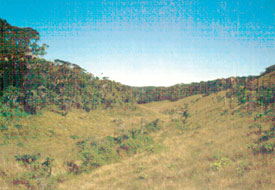|
DAILY NEWS ONLINE |
|
|
|
OTHER EDITIONS |
|
|
|
|
|
|
|
|
|
OTHER LINKS |
|
|
|
|
|
|
  |
 Horton
plains a hiker's delight
|
|
|
At one end of the plateau is World's End, a sheer precipice of 800 to 1,000 metres with a prodigious panorama. Most visitors to the Park are attracted to this phenomenon like iron filings to a magnet.
After they have had an 'eyefull' they go away with a comfortable sense of self-gratulation that they have 'done' Horton Plains thoroughly.
World's End is certainly a major attraction. But it is not why Horton Plains is a national park. If visitors were to exploit the footpaths in the park more thoroughly, only then would they come to realise it is the type of forest which exists there that makes the park a national heritage.
Horton Plains contains the largest extent of upper montane rain forest in the country. These forests are also known as 'cloud forests' because they are quite often enveloped in clouds of mist.
There is a footpath from World's End to Loinorn tea estate overlooking the Bogawantalawa Valley, which will take you across tussocky patna grass and scattered rhododendron trees (ma-ratmal) into a forest that is quite different to anything you will see in the wet and dry lowlands.
The trees are very much smaller, usually about 10 metres high with gnarled branches and small umbrella-shaped crowns that occasionally protrude above the forest canopy. Their appearance has been determined by the climate.
Callophyllum (Keena) is the dominant species with its attractive spread of small white flowers. Some other cloud forest tree species are Simplocos (Bombu), Niolitsea (Dawul-Kurundu), Garcinia (Madol), and a wild cinnamon (C. ovalifolium). Strobilanthus (Nilu) forms a thick underbrush.
A very noticeable characteristic of this forest is the profuse growth of moss and lichens on the trees owing to the misty conditions.
A white lichen (Usnea barbata), commonly called 'Old Man's Beard' is very conspicuous as it hangs from the branches.
Epiphytic orchids may also be seen growing on the trunks of the trees and branches. 'Lily of the Valley' (Epsia bicolor) is quite common.
Belihul-oya
The Belihul-oya, which rises in the Totupola range and meanders across the plains, is subjected to abrupt descents and level flows on its downward course.
This provides another interesting walk to waterfalls and ponds, from Slab Rock falls past Baker's falls, Ford pool, Gempit pool and Governor's pool to the Galagama falls.
If you cross the Belihul-oya just before the Galagama falls, you can continue your hike past the Bogawantalawa-oya to Loinorn estate and join the other walk from World's End.
In the Bogawantalawa area you will come across some trees that were once prominent in that areas before tea took over, ego Gordonia (Mihiriya) and Elaenocarpus (Gal Veralu).
Totapolakanda
There is also a good footpath from the plains to the top of Totupolakanda, the third highest mountain in the country. There are other footpaths also from the Ambawela road and Pattipola road to the summit.
The vegetation at the top is mostly bush and stunted trees, exhibiting die-back caused by a combination of desiccating winds and frost.
Compensating for this disappointment are some wonderful scenic views to Hakgala and Pidurutalagala and across Horton Plains to Kirigalpotta.
A day's outing along any one of these footpaths could be a rewarding experience well worth the effort, with the prospective bonus of seeing some rare birdlife eg. Yellow Eared Bulbul, Rufus Babbler and Blue Magpie.
Also Rainbow Trout in the streams. Once an introduced species, this trout now breeds there naturally, feeding on flies, their larvae and the endemic shrimp Caridina Singhalensis.
Last word
Horton Plains and the Peak Wilderness together represent the largest undisturbed extent of cloud forest in the island. And since they are contiguous it would be desirable from a biodiversity conservation point of view and public education to have them combined into a single national park and natural heritage.
|
|

